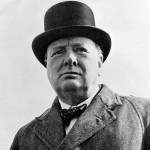nimitz

 While researching some of the larger battles of World War II, I began to consider the brilliance of the men who planned these battles. Men like Sir Winston Spencer-Churchill, Supreme Allied Commander General Dwight D Eisenhower, Admiral Chester Nimitz, Admiral Frank Fletcher, and Admiral Raymond Spruance (who was a replacement, but proved to be instrumental in the success of Midway). These men and others like them knew that the stakes were high, and by sheer numbers, the Allies were outnumbered by the Axis armies. That said, they also knew that the fate of the world was in their hands. If they lost this war, the Japanese and Germans would quite likely take over and rule the world. Life as we knew it would cease to exist.
While researching some of the larger battles of World War II, I began to consider the brilliance of the men who planned these battles. Men like Sir Winston Spencer-Churchill, Supreme Allied Commander General Dwight D Eisenhower, Admiral Chester Nimitz, Admiral Frank Fletcher, and Admiral Raymond Spruance (who was a replacement, but proved to be instrumental in the success of Midway). These men and others like them knew that the stakes were high, and by sheer numbers, the Allies were outnumbered by the Axis armies. That said, they also knew that the fate of the world was in their hands. If they lost this war, the Japanese and Germans would quite likely take over and rule the world. Life as we knew it would cease to exist.
Strategy is everything. Of course, part of that strategy involves something that many Americans have come to hate these days…fake news. These strategic minds knew that somehow they had to fool the Japanese into believing that no attack was coming, or that the advancing armies were headed elsewhere. It sounds simple, but this wasn’t the movies. Nevertheless, information was leaked to the enemy, while the Allied armies advanced as planned. The strategy worked perfectly on D-Day when Hitler was fooled, by men he had called idiots, into thinking that the target was at some point along their Atlantic Wall…the 1,500-mile system of coastal defenses that the German High Command had constructed from the Arctic Circle to Spain’s northern border…or even as far away as the Balkans. Vital to Operation Bodyguard’s success were more than a dozen German spies in Britain who had been discovered, arrested and flipped by British intelligence officers. The Allies  fed faulty information to these Nazi double agents to pass along to Berlin. A pair of double agents nicknamed Mutt and Jeff relayed detailed reports about the fictitious British Fourth Army that was gathering in Scotland with plans to join with the Soviet Union in an invasion of Norway. The Allies also fabricated radio chatter about cold-weather issues such as ski bindings and the operation of tank engines in subzero temperatures. The plan worked as Hitler sent one of his fighting divisions to Scandinavia just weeks before D-Day.
fed faulty information to these Nazi double agents to pass along to Berlin. A pair of double agents nicknamed Mutt and Jeff relayed detailed reports about the fictitious British Fourth Army that was gathering in Scotland with plans to join with the Soviet Union in an invasion of Norway. The Allies also fabricated radio chatter about cold-weather issues such as ski bindings and the operation of tank engines in subzero temperatures. The plan worked as Hitler sent one of his fighting divisions to Scandinavia just weeks before D-Day.
At Midway, the American “Doolittle” raid, a propaganda air attack on Tokyo launched from the carrier USS Hornet, prompted Japanese Admiral Isoroku Yamamoto to plan a final showdown with the remnants of the American fleet before letting his forces rest. The “Doolittle” raid had been an insult and it had threatened the life of the emperor. Yamamoto was confident that he had the advantage in numbers and quality to destroy the American carrier fleet. He planned to confuse the enemy with a diversionary attack on the Alaskan coast, drawing the Americans north, only to launch his main attack on Midway Island the following day, which would see the Americans hurrying south, into an ambush. With a great show of overelaboration, which was typical of Japanese military planning. Yamamoto divided his force into three main groups. There were four big carriers, the battlefleet, and the invasion force. These three groups were too far apart for mutual support. The Japanese carrier group operated in close order, commanded by Admiral Nagumo, who had led them for the attack at Pearl Harbor. Nimitz, for his part, could not hope to win a direct engagement. He had to stake everything on exploiting his intelligence windfall, and try to ambush the enemy. He secretly reinforced the air units on Midway, using the island as an unsinkable aircraft carrier. His sea-going carriers were positioned to the 
 northeast of the island, waiting to ambush the Japanese carriers when they arrived for their assault. The American tactics relied on the peculiar characteristics of carrier warfare. Nimitz knew the first attack would be decisive for either side, carriers being full of fuel and ordnance, hence highly vulnerable to bombs and torpedoes. The American tactical commanders, admirals Frank Fletcher and Raymond Spruance, also knew they were playing for very high stakes. They kept the two task forces separate. The strategy worked, and the Japanese never fully recovered.
northeast of the island, waiting to ambush the Japanese carriers when they arrived for their assault. The American tactics relied on the peculiar characteristics of carrier warfare. Nimitz knew the first attack would be decisive for either side, carriers being full of fuel and ordnance, hence highly vulnerable to bombs and torpedoes. The American tactical commanders, admirals Frank Fletcher and Raymond Spruance, also knew they were playing for very high stakes. They kept the two task forces separate. The strategy worked, and the Japanese never fully recovered.

